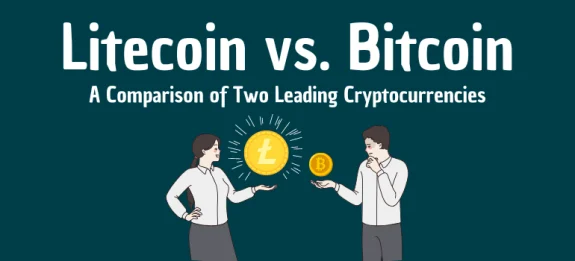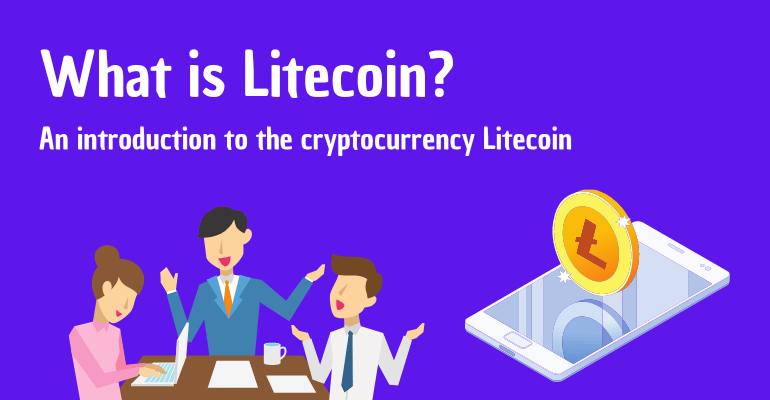
Litecoin vs. Bitcoin – A Comparison of Two Leading Cryptos
Often regarded as the digital world’s equivalents of gold and silver, Bitcoin and Litecoin have…

The world had already been steeped in the cryptocurrency game with Bitcoin when Litecoin first arrived on the market. So, why did we need another when we already have one?
Litecoin is a digital currency like Bitcoin, but faster and cheaper. It’s decentralized and secure, making it a convenient way to exchange value.
Sounds complicated? Don’t worry, folks! If the name Litecoin strikes your interest and you want to know what it is, how it works, and even where you can buy and sell Litecoin, today’s article is all about that!
Imagine you want to trade something but don’t want third-parties to snoop on you. Thus, instead of using money, you use a computer token, a special kind of code that is stored on a giant ledger on the internet that everyone with the token has access to. That’s basically cryptocurrency!
Created in 2011, Litecoin is the first alternative cryptocurrency to Bitcoin, which also paved the way for several other cryptocurrencies now available on the market.
Let’s explore the basics of Litecoin, how it functions and secures your every transaction, and for what potential benefits we needed Litecoin in the first place.
Litecoin, abbreviated LTC, is a peer-to-peer digital currency adapted from Bitcoin’s original source code. Peer-to-peer means that no central authority, like a bank or government, controls it. Instead, the financial transactions on Litecoin are managed collectively by the network of users.
Similar to other decentralized cryptocurrencies, Litecoin is not created or regulated by a government entity, which has traditionally been responsible for issuing money. Thus, Litecoin allows fast and instant transactions from anywhere to anywhere without third-party monitoring.
Instead of being controlled by a bank and printed by an official organization, Litecoins are generated through a complex process known as mining.
Mining requires high-powered computers to solve complex math problems in order to verify transactions. When a new block of transactions is verified and added to the blockchain, the miner receives a small reward in Litecoin.
Mining Litecoin comes with its own rewards. The first miner to successfully validate a block receives 12.5 Litecoins as a reward. However, just like Bitcoin, the number of Litecoins awarded decreases over time.
Here, it’s important to note that the total number of Litecoins is fixed by the creators so that it ceases to have an endless supply, stopping it from leading to inflation and devaluation.
Thus, in August 2019, the Litecoin mining reward was halved, and this halving process will continue at regular intervals until the 84,000,000th Litecoin (circulation limit) is mined.
According to the Litecoin Foundation, it is estimated that this maximum limit of 84 million Litecoins will be reached around the year 2142.
Our exploration has yet to answer two important queries. First, how the entire structure is powered and maintained, and second, how the security of the fund is guaranteed. To answer those questions, let’s take a dive into how blockchain and securing algorithms keep Litecoins working!
At first, blockchain could sound intimidating, but we’ll break it down for you in plain. Picture a giant, unchangeable ledger, or a notebook, that keeps track of every single Litecoin transaction ever made.
Now, let’s say a group of friends keeps track of each other’s transactions in that notebook. Everyone has a copy of the notebook, and every time someone makes a trade, they write it down. If someone tries to cheat, the other friends will know because they all have a copy of the notebook.
This is how the blockchain works. It’s a digital ledger that keeps track of transactions in a secure and transparent way. Future advancements only suggest that Blockchain has the potential to revolutionize the financial system by making transactions faster, cheaper, and more secure.
Have you ever tried to guess someone’s password or crack a secret code? It’s really hard!
That’s because the more complex a password or code is, the harder it is to figure out. That’s kind of what the Scrypt algorithm does for Litecoin—it makes solving complex math problems really difficult for computers, so it’s super secure!
In essence, PoW requires that one party demonstrate to the other network participants that the necessary amount of computation has been made. Litecoin utilizes the less resource-demanding Scrypt PoW hash approach in contrast to Bitcoin, which employs the SHA-256 (PoW) hash algorithm.
When you make a transaction with Litecoins, powerful computers called miners race to solve those tricky math problems I mentioned before.
Scrypt makes it extremely hard to find a hash that matches a transaction by requiring a lot of computational power and memory. This makes it nearly impossible for hackers to create fake transactions, even with more powerful computers than the world’s supercomputers.
In other words, Scrypt makes it very difficult to cheat the system.
As a result, your Litecoin transactions are exceptionally secure thanks to Scrypt. The network incentivizes honest miners with Litecoin rewards, eliminating the need for banks or governments to safeguard your money.
Charlie Lee, a former Google employee, created Litecoin in 2011 as a faster, cheaper alternative to Bitcoin. He also wanted to address concerns that Bitcoin was becoming too centralized, making it easier for large mining companies to dominate the network.
Litecoin has a faster block generation rate, lower transaction fees, and a higher maximum supply than Bitcoin. Its hashing algorithm, Scrypt, is more memory-intensive, making it more decentralized.
Lee created Litecoin to complement rather than compete with Bitcoin. Litecoin was intended to be used for small, everyday transactions, while Bitcoin would be better suited for high-value transactions.
Litecoin is one of the earliest cryptocurrencies in the top tier of market capitalization and shares many characteristics with Bitcoin, making it a popular crypto investment. LTC can be purchased online on a platform or market that deals in cryptocurrencies, or it can be mined.
Once you have Litecoin, you can choose from a variety of market investment strategies. Also, get familiar with blockchain technology, and factors influencing cryptocurrency values, and stay updated with the latest news and developments.
Select a reputable cryptocurrency exchange or eWallet that supports Litecoin. Popular exchanges like Coinbase, Binance, and Kraken offer a user-friendly experience, robust security measures, and competitive fees.
Also, research their features, security protocols, and user reviews before making your decision. Feel free to check out our list of trusted and legit eWallets and compare them yourself.
Coinbase: One of the simplest ways for beginners to purchase Litecoin using fiat money like USD or EUR is through Coinbase.
Binance: Leading cryptocurrency exchange Binance offers numerous currency pairs, including LTC, and large trade volumes.
Kraken: Kraken is another reputable crypto exchange that offers LTC trading alongside USD, EUR, and various other currencies.
eToro: You can purchase and trade LTC CFDs on the social trading platform eToro without really holding the asset.
You can transfer LTC to an eWallet or store it in some exchanges’ built-in wallets. Just remember that before registering, always look into the costs and security procedures of an exchange.
If you decide to sell your Litecoin, you can do so on the same cryptocurrency exchange where you originally bought it. In reverse, the procedure is comparable to purchasing.
Simply log into your exchange account, choose the trading interface, and place a sell order for your Litecoin, indicating the quantity you wish to sell and the price at which you wish to be paid.
If your sell order matches a buy order on the exchange, the transaction will be executed, and your Litecoin will be sold. When the transaction is finished, you can either keep the money on the exchange for future trading or withdraw it to your bank account.
Bear in mind that different cryptocurrency exchanges might have varying withdrawal thresholds and protocols, so make sure to get to know the specifics of the process at the exchange you’ve chosen.
Given its status as one of the first and best-known cryptocurrencies, LTC transactions are cheaper and faster compared to BTC transactions. Bitcoin is more popular and has a higher value per coin, though.
Even though Bitcoin Cash, Dash, and other alternatives claim to have faster transaction times than Bitcoin, Litecoin is still among the top ten largest cryptocurrencies in terms of market capitalization.
In the end, each cryptocurrency has its own strengths and uses. Just like fiat currencies, there is no one perfect crypto. Yet, Litecoin manages to carve out its niche by balancing speed and affordability.
You can explore further distinctions between Litecoin and Bitcoin in this article, where we delve into detail about what sets these two cryptocurrencies apart.
In short, Litecoin is a digital currency like Bitcoin, but with faster transactions and a higher supply. Though the crypto market is volatile, its value could continue to rise as more people adopt it.
Most importantly, if anonymity and security are your top concerns, Litecoin might just be the most lightweight altcoin option you’re looking for.